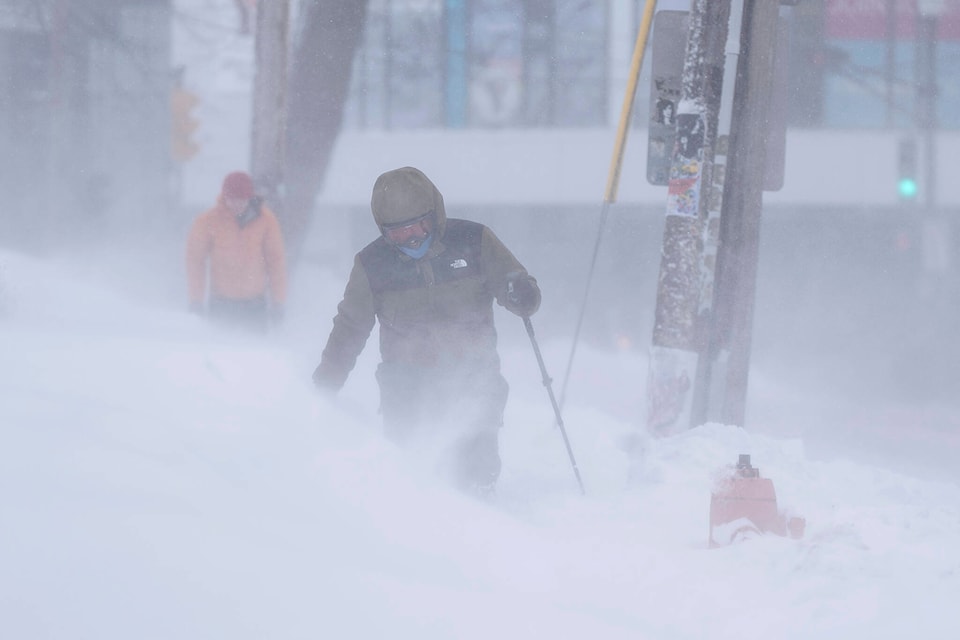The Nova Scotia government is asking Ottawa for help as the province digs out from an “extreme snowfall” that has prompted parts of Cape Breton to declare local states of emergency.
A stalled low-pressure system off the province’s east coast dumped heavy snow across the eastern half of the mainland and in Cape Breton, where preliminary observations showed more than 100 centimetres had piled up in the Sydney area since Friday.
On Monday afternoon, Nova Scotia’s minister responsible for emergency management, John Lohr, released a letter to federal Emergency Preparedness Minister Harjit Sajjan, saying the province needs heavy equipment to help with snow removal.
Lohr is also asking for portable fuel storage equipment and air transport assistance to help with the delivery of critical supplies and the evacuation of isolated people.
Nova Scotia has already asked for help from neighbouring provinces, but Lohr says Ottawa must step in to restore public safety, as it could take days to clear transportation links.
“Our province has experienced a rare extreme snowfall event that has brought particularly severe impacts to northeastern Nova Scotia and Cape Breton,” Lohr wrote. “More assistance is still required to open roads and restore the flow of essential goods and personnel.”
Meanwhile, the mayor of the Cape Breton Regional Municipality, Amanda McDougall, was urging residents to stay at home.
Even though the weather improved on Monday, McDougall said a sense of panic was setting in among those feeling stranded and isolated.
“At my house, for example, we have a good five-foot drift that’s sitting at the end of our driveway, so we can’t get out,” she said in an interview. “It’s not going to be a quick process to dig out of this.”
McDougall said staff at Cape Breton’s Ally Centre and the community homeless shelter in Sydney have been reaching out to vulnerable residents.
“I know there are still people living in tents … And there are seniors who live alone who I’m also really, really concerned for,” she said, adding that the municipality is drafting a registry of people who need help, as it did during post-tropical storm Fiona in September 2022.
The mayor said she and her council colleagues declared a weeklong local state of emergency on Sunday in a bid to get more snow-clearing equipment from the province.
“We don’t have the infrastructure or resources as a municipality to deal with the incredible dump of snow that we have here,” she said.
On Monday morning, Environment Canada said a volunteer weather observer had recorded 150 centimetres of snow in Sydney, the largest community in Cape Breton. As well, 103 cm of snow was measured at the Sydney airport, and 98 cm fell over Ingonish on the island’s northeast coast.
Images posted on social media showed huge snowdrifts atop homes and outbuildings, buried and abandoned vehicles strewn across major highways, and homeowners using shovels to carve tunnel-like paths just to move around their properties.
“There’s several reports around various parts of Cape Breton of over 100 centimetres (of snow),” said Ian Hubbard, a Halifax-based meteorologist with Environment Canada.
The Eskasoni First Nation, about 40 kilometres southwest of Sydney, declared a local state of emergency early Monday.
“Eskasoni First Nation has exhausted all resources, with snow removal-capable vehicles within the community becoming stuck or otherwise unable to continue operations,” the band said in an online post.
More than 70 cm of snow was reported in eastern Nova Scotia, and strong winds since Friday sculpted massive drifts that will take days to clear.
According to preliminary reports from the Halifax area, between 30 and 50 cm fell across the city, but 84 cm was reported at Halifax Stanfield International Airport only 30 kilometres away. Scores of flights were cancelled or delayed at the region’s busiest airport, and more than 7,000 power outages were reported across the province Monday morning.
Schools were closed, and government offices delayed opening or closed for the day, except in the western municipalities, where the snowfall was much lighter.
Strong winds over the weekend made it difficult to measure the snowfall, said Hubbard.
“That’s a tricky thing,” he said. “That’s why I put the disclaimers on there.”
Northeast of the Halifax region, for example, communities in Pictou County reported between 50 and 100 cm of snow.
In Prince Edward Island, a provincial byelection slated for Monday was postponed until Tuesday. Tim Garrity, CEO of Elections PEI, issued a statement saying the storm’s track shifted westward overnight, causing dangerous driving conditions across the Island.
“We want voters to exercise their right to vote, but in a safe manner,” Garrity said.
Hubbard said the centre of the storm parked itself south of Cape Sable Island on Friday afternoon and it barely budged until Monday morning, when it started to break apart.
“Typically with a winter storm they tend to move up to the north or northeast and they move through and we might get 12 to 18 hours of snow,” Hubbard said. “But this one did stall and that … kept the source of moisture there, so it was able to continually tap into moisture to produce snow.”
It was almost 20 years ago that a more powerful snowstorm slammed into the region, dumping up to 95 cm of snow in and around the Halifax area. That storm, known as White Juan, came five months after hurricane Juan made landfall near Halifax, churning out damaging gusts at 140 kilometres per hour.
On Friday, Nova Scotia’s most famous groundhog, Shubenacadie Sam, emerged on a cloudy Groundhog Day, which prompted his handlers to proclaim springlike weather would soon arrive. Snow started falling later that day and continued all weekend.
On Monday, temperatures rose close to the freezing point or just above as the storm system moved farther offshore. Hubbard said fair weather was in the forecast for the rest of the week, though bands of snow were still moving through northern Nova Scotia on Monday morning.
READ ALSO:



